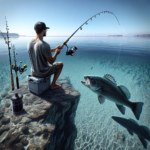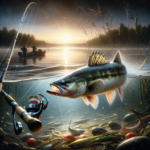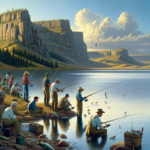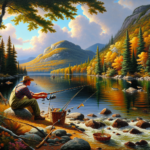Fishing Tips on How to Catch Black Sea Bass

Introduction
Black Sea Bass (Centropristis striata) is a popular target for both sport and recreational anglers due to its abundance, fighting spirit, and delicious taste. This species is highly sought after along the Atlantic coast of the United States, from Maine to Florida. In this article, we will delve into the essential aspects of catching Black Sea Bass, including their characteristics, habitats, and behaviors. We will also provide detailed fishing techniques, recommended gear, and tips for ethical catch and release practices.
Fish Species Overview
Description
Black Sea Bass are easily recognizable by their dark, dusky coloration, which can range from black to a deep blue or green. They have a distinctive hump on their head, especially prominent in larger males. These fish typically grow to about 10-20 inches in length and can weigh up to 5 pounds, although larger specimens are not uncommon.
Habitat
Black Sea Bass prefer saltwater environments and are commonly found along the Atlantic coast. They inhabit rocky bottoms, reefs, and wrecks, where they can find ample food and shelter. These fish are also known to frequent estuaries and bays, particularly during their juvenile stages.
Behavior
Black Sea Bass are opportunistic feeders, preying on a variety of marine life, including crustaceans, small fish, and mollusks. They are most active during the day, with peak feeding times occurring during dawn and dusk. Spawning typically occurs from May to July, with females releasing eggs that are fertilized externally.
Challenges
Anglers targeting Black Sea Bass often face challenges such as locating the fish, dealing with their cautious nature, and navigating the rocky or reef-filled environments they inhabit. Additionally, seasonal migrations can make it difficult to predict their exact locations.
Best Time to Catch Black Sea Bass
Seasonal Considerations
The optimal time to catch Black Sea Bass is during the spring and summer months, particularly from May to September. During this period, the fish are more active and can be found in shallower waters, making them more accessible to anglers.
Time of Day
Black Sea Bass are most active during the early morning and late afternoon. These times coincide with their natural feeding patterns, increasing the likelihood of a successful catch.
Weather Conditions
Ideal weather conditions for catching Black Sea Bass include overcast days with calm waters. These conditions reduce the fish’s visibility of anglers and their gear, making them more likely to bite. Additionally, stable weather patterns without sudden changes in temperature or pressure are favorable.
Top Fishing Techniques for Black Sea Bass
Technique 1: Bottom Fishing
Bottom fishing is one of the most effective techniques for catching Black Sea Bass. This method involves dropping baited hooks to the ocean floor, where the fish are likely to be feeding. Using a weighted rig helps keep the bait in place and attracts the fish’s attention.
Technique 2: Jigging
Jigging involves using a weighted lure that is jerked up and down to mimic the movement of prey. This technique is particularly effective for Black Sea Bass, as it triggers their predatory instincts. Metal jigs and soft plastic lures are commonly used for this method.
Technique 3: Drift Fishing
Drift fishing allows anglers to cover a larger area by letting the boat drift with the current while keeping baited lines in the water. This technique is useful for locating schools of Black Sea Bass and can be combined with bottom fishing or jigging for increased effectiveness.
Pro Tips
- Use fresh bait such as squid, clams, or small fish to attract Black Sea Bass.
- Pay attention to tidal movements, as fish are more likely to feed during incoming or outgoing tides.
- Experiment with different jigging speeds and patterns to find what works best on a given day.
Recommended Gear for Catching Black Sea Bass
Fishing Rod and Reel
A medium to heavy-action rod paired with a sturdy reel is ideal for catching Black Sea Bass. Spinning reels are popular due to their ease of use and versatility, but conventional reels can also be effective, especially for bottom fishing.
Fishing Line
Braided line with a strength of 20-30 pounds is recommended for Black Sea Bass fishing. Braided lines offer excellent sensitivity and strength, allowing anglers to feel even the slightest bites and handle the fish’s strong runs.
Hooks and Baits
Circle hooks in sizes 2/0 to 4/0 are commonly used for Black Sea Bass. These hooks are designed to reduce gut hooking and increase the chances of a successful release. Natural baits such as squid, clams, and small fish are highly effective, while artificial lures like jigs and soft plastics can also yield good results.
Additional Gear
- Sinkers: Use appropriate weights to keep your bait near the bottom.
- Leaders: Fluorocarbon leaders of 20-30 pounds can help prevent line breakage and increase stealth.
- Fish Finder: A fish finder can help locate schools of Black Sea Bass and identify underwater structures where they may be hiding.
Best Locations to Find Black Sea Bass
General Locations
Black Sea Bass are typically found in coastal waters, particularly around rocky bottoms, reefs, and wrecks. They can also be found in estuaries and bays, especially during their juvenile stages.
Specific Regions
Popular regions for Black Sea Bass fishing include the Atlantic coast of the United States, from Maine to Florida. Notable spots include the Chesapeake Bay, Long Island Sound, and the waters off the coast of New Jersey and North Carolina.
Common Mistakes to Avoid
Mistake 1: Using the Wrong Bait
Using inappropriate or stale bait can significantly reduce your chances of catching Black Sea Bass. Always use fresh, high-quality bait that mimics the fish’s natural prey.
Mistake 2: Ignoring Tidal Movements
Tidal movements play a crucial role in the feeding patterns of Black Sea Bass. Ignoring these movements can result in missed opportunities. Plan your fishing trips around incoming or outgoing tides for the best results.
Mistake 3: Inadequate Gear
Using gear that is too light or not suited for bottom fishing can lead to lost fish and frustration. Ensure you have the appropriate rod, reel, line, and terminal tackle for the job.
Catch and Release Tips
Importance of Conservation
Practicing catch and release is essential for maintaining healthy fish populations and ensuring the sustainability of the species. Ethical fishing practices help preserve the ecosystem and allow future generations to enjoy the sport.
Proper Handling Techniques
- Use wet hands or a wet cloth to handle the fish, reducing the removal of their protective slime coating.
- Avoid touching the gills or eyes, as these areas are particularly sensitive.
- Use a dehooking tool to remove the hook quickly and gently.
- Release the fish as soon as possible to minimize stress and increase their chances of survival.
Legal Considerations
Be aware of local regulations regarding size limits, bag limits, and protected areas. These regulations are in place to ensure the sustainability of fish populations and must be followed at all times.
Frequently Asked Questions (FAQs)
What is the best bait for catching Black Sea Bass?
The most effective baits for Black Sea Bass include squid, clams, and small fish. These natural baits closely mimic the fish’s natural prey and are highly attractive to them. Artificial lures such as jigs and soft plastics can also be effective, especially when jigged near the bottom.
Where is the best place to fish for Black Sea Bass?
Black Sea Bass are commonly found in coastal waters with rocky bottoms, reefs, and wrecks. Popular fishing spots include the Chesapeake Bay, Long Island Sound, and the waters off the coast of New Jersey and North Carolina.
What time of day is best for catching Black Sea Bass?
The best times to catch Black Sea Bass are during the early morning and late afternoon. These times coincide with their natural feeding patterns, increasing the likelihood of a successful catch.
What type of fishing line should I use for Black Sea Bass?
Braided line with a strength of 20-30 pounds is recommended for Black Sea Bass fishing. Braided lines offer excellent sensitivity and strength, allowing anglers to feel even the slightest bites and handle the fish’s strong runs.
Do I need a special fishing license to catch Black Sea Bass?
Yes, a fishing license is typically required to catch Black Sea Bass. Licensing requirements vary by state, so it’s important to check local regulations before heading out. Be aware of size limits, bag limits, and any special permits needed.
What is the best technique for catching Black Sea Bass?
Bottom fishing is one of the most effective techniques for catching Black Sea Bass. This method involves dropping baited hooks to the ocean floor, where the fish are likely to be feeding. Jigging and drift fishing are also effective techniques.
Are there any specific weather conditions that improve the chances of catching Black Sea Bass?
Ideal weather conditions for catching Black Sea Bass include overcast days with calm waters. These conditions reduce the fish’s visibility of anglers and their gear, making them more likely to bite. Stable weather patterns without sudden changes in temperature or pressure are also favorable.
Can I catch Black Sea Bass from the shore, or do I need a boat?
While Black Sea Bass can be caught from shore, fishing from a boat often provides better access to their preferred habitats, such as rocky bottoms, reefs, and wrecks. Shore fishing can be effective in estuaries and bays, especially during the fish’s juvenile stages.
How can I improve my chances of landing a big Black Sea Bass?
To increase your chances of catching larger Black Sea Bass, use fresh bait, fish during peak feeding times (early morning and late afternoon), and target areas with abundant food sources, such as rocky bottoms and reefs. Using heavier gear can also help handle larger fish.
What should I do if I plan to release Black Sea Bass after catching them?
If you plan to release Black Sea Bass, practice ethical catch and release techniques. Handle the fish with wet hands or a wet cloth, avoid touching sensitive areas like the gills and eyes, use a dehooking tool to remove the hook quickly and gently, and release the fish as soon as possible to minimize stress.
Conclusion
Catching Black Sea Bass can be a rewarding experience for anglers of all skill levels. By understanding their characteristics, habitats, and behaviors, and by using the right techniques and gear, you can increase your chances of a successful catch. Remember to practice ethical fishing practices and follow local regulations to ensure the sustainability of this valuable species. With the tips provided in this article, you’re well-equipped to embark on your next Black Sea Bass fishing adventure. Happy fishing!




